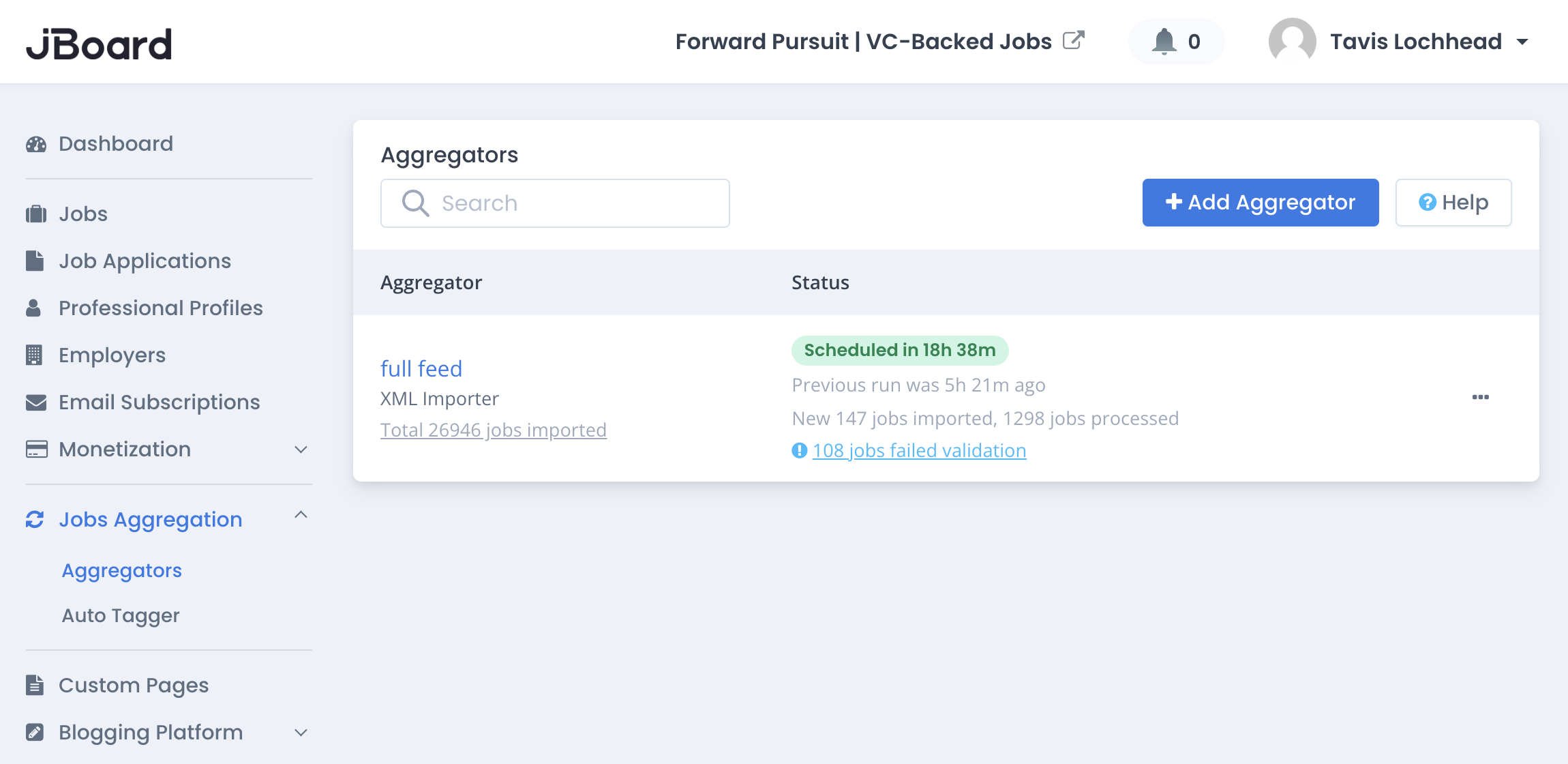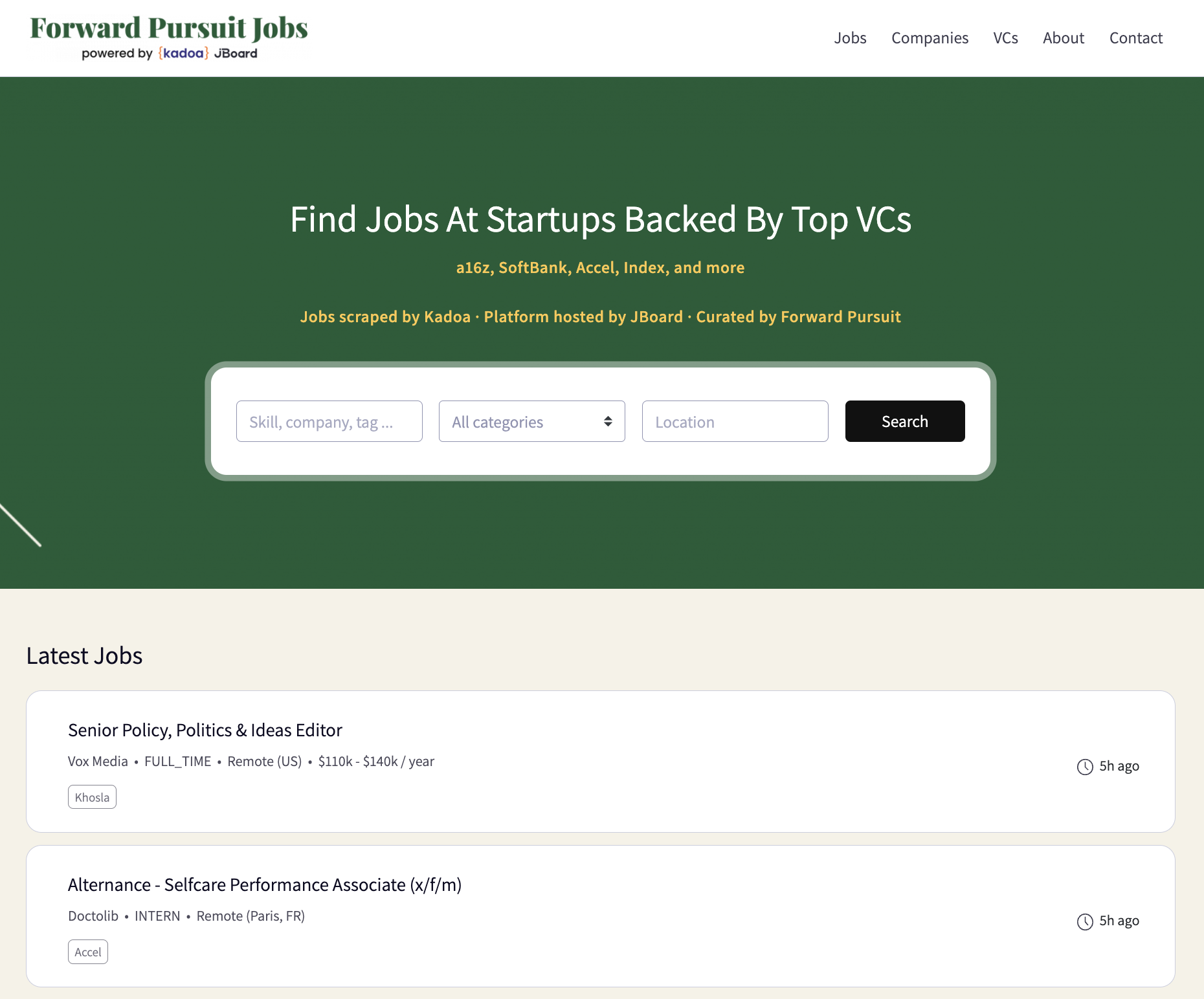The job market moves fast. To stay competitive, you need to quickly find and share the best job opportunities with top talent.
But creating a job board from scratch can seem like a very time-consuming and expensive project, but it doesn't have to be.
This guide will walk you through how to build a job board in just one day using Kadoa for job scraping and JBoard as a job board platform.
We'll share how we used these tools to create a specialized job board showcasing positions at startups backed by top VCs, and provide tips on how to grow and monetize your job board once it's up and running.
Choosing the Right Tools
When building a job board, the core components include a job board platform and a reliable source for job feeds. These tools are critical for hosting, managing, and publishing job listings efficiently.
Job Board Platform
The platform choice can greatly influence both the functionality and management ease of your job board:
- Job Board Software (e.g., JBoard) like JBoard offers user-friendly, no-code setup but limited customization.
- Custom Development provides total control but is resource-intensive and time-consuming.
We chose JBoard for its intuitive, no-code interface, which simplifies the process of managing job boards, allowing us to focus on strategy rather than technical challenges.
Sourcing Job Postings
There are several ways to source job data:
1. Purchasing Job Feeds From a Data Provider
Pros:
- Quick Setup: Purchasing job feeds allows for rapid accumulation of job listings.
- Broad Coverage: Feeds often cover a wide geographic and industry spectrum, providing a diverse array of job opportunities.
Cons:
- Generic Data: The data may not be tailored to the specific needs of your job board or niche, resulting in less relevance.
- Cost: While it saves on development time, it can be expensive, especially for high-quality, comprehensive feeds.
2. Using Third-Party Scraping Solutions
Pros:
- Control: Allows precise targeting of specific job boards or company sites, ensuring relevance.
- Flexibility: Custom scrapers can be adjusted as source sites change their layout or data structure.
Cons:
- High Cost: Custom development and maintenance of scrapers can be costly.
- Slow Setup: Takes time to develop and may need frequent updates to maintain effectiveness.
3. Coding Your Own Scrapers
Pros:
- Customization: Complete control over the scraping process, tailored exactly to your needs.
- Cost-Effective: No ongoing fees beyond initial development if maintained internally.
Cons:
- Resource Intensive: Requires skilled developers and significant time investment.
- Maintenance: Needs continuous monitoring and updating due to potential changes on the target websites.
Introducing Kadoa: An AI-powered Job Scraping Solution
Kadoa represents a fourth option, leveraging artificial intelligence to automate the scraping process end-to-end, thus addressing many of the drawbacks of traditional scraping methods.
- AI Automation: Kadoa uses AI to quickly develop scrapers, significantly reducing setup time and ongoing maintenance needs.
- Cost Efficiency: Kadoa reduces the costs associated with manual coding by automating the development and maintenance of scraping scripts.
- Scalability: AI-driven processes easily scale to handle an increase in sources or frequency of scraping, adaptable to the growth of your job board.
- Reliability: Advanced algorithms ensure that data capture remains consistent and accurate, even as source websites change.
- Data Quality: Kadoa's AI-driven data processing generates consistently high-quality data feeds that enhance job matching and SEO opportunities.
Sourcing Jobs: Kadoa vs Alternatives
| Data Provider | Third-Party / In-House | Kadoa |
|---|
| Speed | Jobs available instantly | 1-3 business days to build | 10-30 minutes to build |
|
| Cost | No setup costs, per job pricing | Setup costs, high price per source | No setup costs, medium price per source |
|
| Maintenance | None | High, 1-3 days downtime when scrapers break | None |
|
| Coverage | Patchy, limited to feed's coverage | High coverage | High coverage |
|
| Data Quality | Variable quality | Not fully uniform data | AI-powered processing producing uniform data |
Step-by-Step Guide to Building a Job Board
Step 1: Select Your Job Sources

First, we identified top venture capitalists whose portfolio companies we wanted to target. This included:
- a16z (https://portfoliojobs.a16z.com/jobs)
- SVA (https://jobs.svangel.com/jobs)
- Khosla (https://jobs.khoslaventures.com/jobs)
- Accel (https://jobs.accel.com/jobs)
- Menlo (https://jobs.menlovc.com/jobs)
- General Catalyst (https://jobs.generalcatalyst.com/jobs)
Step 2: Add URLs to Kadoa
Each URL was added to Kadoa, which then took between 10 to 60 minutes to generate the necessary scrapers.
Step 3: Set Up JBoard
With the scrapers in place, the next step was to add the XML feeds generated by Kadoa to JBoard. JBoard typically imports the jobs in about 10 minutes.
XML example.

Step 4: Customize and Launch
Finally, we customized the look and feel of the job board to align with branding and assigned a domain for the site. Within a few hours, the job board was fully functional and ready to connect job seekers with exciting opportunities.

See the live job board at jobs.forwardpursuit.vc.
Expansion and Monetization Guide
Now that you published your job board and filled it with job postings, it's time to think about monetization and growth strategies. Here are some areas to focus on:
Niche Targeting
Targeting a niche market can be a powerful way to differentiate your service from large-scale aggregators like Indeed. For instance, you could specialize in startup jobs at companies funded by notable venture capitalists. This focus allows you to offer unique value by connecting job seekers with opportunities in dynamic startup environments and helping startups find candidates who are passionate about working in the venture-backed sector. Consider how you can carve out a niche that aligns with your strengths and market needs.
Monetization Strategies
Now that you have some traffic, how can you monetize it? Here are a few options to think about:
- Sponsored Posts: Allow employers to pay for their job listings to be highlighted on your platform. This can increase visibility for their postings and generate additional revenue for your board.
- Subscription Models: Offer tiered subscription levels that provide access to premium features, such as detailed analytics or advanced job posting capabilities. This can appeal to recruiters and HR departments looking for deeper insights and more visibility.
- Company Branding: Create opportunities for enhanced company profiles and featured employer spots. This can help companies stand out to potential applicants and strengthen their employer brand.
- Competitiveness Analysis for Job Seekers: Provide a service that offers job seekers insights into how their qualifications stack up against other candidates. This can be a valuable tool for job seekers looking to improve their resumes and interview strategies.
SEO Optimization
Optimizing your job board for search engines is essential for driving traffic and improving site visibility. Kadoa automatically generates rich jobPosting schema markup for each listing.
This structured data helps search engines like Google better understand and index your job postings, improving their visibility in search results.
To further optimize your job board for SEO:
- Leverage rich JobPosting schema: Kadoa automatically populates key attributes like job title, description, employer, and application link in a structured format preferred by Google Jobs. This boosts SEO while enhancing the search experience for job seekers.
- Create categorized pages: Create pages categorized by job type, industry, or location, which are optimized for specific job-related queries. This organization makes it easier for your pages to rank higher in search results and helps job seekers find relevant listings quickly.
- Use relevant keywords: Ensure that your content incorporates relevant keywords and phrases that job seekers are likely to use in their searches. This includes job titles, skills, and location, among other pertinent details.
- Keep content updated: Regularly update your content to keep it relevant and engaging. Frequent updates signal to search engines that your site is active, which can help to maintain or improve your rankings over time.
By integrating Kadoa's advanced scraping and data structuring capabilities with these SEO strategies, you can significantly enhance the reach and effectiveness of your job board, making it a go-to resource in a competitive market.
Conclusion
Building a job board no longer requires extensive technical know-how or significant time investment. With AI-powered tools like Kadoa and no-code platforms like JBoard, it's possible to launch a curated job board in just a day.
To grow your job board:
- Focus on a specific niche
- Implement smart monetization strategies
- Continuously optimize for search engines
Please reach out if you're interested in using Kadoa for creating or growing your own job board.
 Tavis Lochhead,Co-Founder of Kadoa
Tavis Lochhead,Co-Founder of Kadoa

